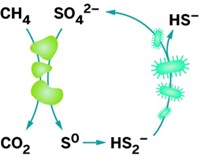Advertisement
Grab your lab coat. Let's get started
Welcome!
Welcome!
Create an account below to get 6 C&EN articles per month, receive newsletters and more - all free.
It seems this is your first time logging in online. Please enter the following information to continue.
As an ACS member you automatically get access to this site. All we need is few more details to create your reading experience.
Not you? Sign in with a different account.
Not you? Sign in with a different account.
ERROR 1
ERROR 1
ERROR 2
ERROR 2
ERROR 2
ERROR 2
ERROR 2
Password and Confirm password must match.
If you have an ACS member number, please enter it here so we can link this account to your membership. (optional)
ERROR 2
ACS values your privacy. By submitting your information, you are gaining access to C&EN and subscribing to our weekly newsletter. We use the information you provide to make your reading experience better, and we will never sell your data to third party members.
Biochemistry
Double-duty bacterium guzzles both methane and sulfur
Newly found microbe may help mitigate methane emissions from wetlands
by Alla Katsnelson, special to C&EN
August 10, 2022
| A version of this story appeared in
Volume 100, Issue 28

Methane is a potent greenhouse gas that plays a major role in Earth’s warming. Ecological regions called wetlands, where water covers soil for at least part of the year, are a major source of methane emissions. Methane-oxidizing bacteria in wetlands soil can tamp down methane release there.
Now, researchers have discovered bacteria living in wetlands that chow down not just on methane but also on sulfur—a combined metabolism never before observed in bacteria (Proc. Natl. Acad. Sci. U.S.A. 2022, DOI: 10.1073/pnas.2114799119). Bacteria that oxidize either sulfur or methane generally grow on different substrates, “so obtaining a bacterium that bridges the gap between these two functional groups is unique and surprising,” explains Sung-Keun Rhee, a microbiologist at Chungbuk National University who led the work. What’s more, Rhee says, sulfur oxidation can decrease methane emissions further, so this newly found microbe is working a double shift.
Five years ago, Rhee and colleagues set out to look for methane-metabolizing bacteria— also called methanotrophs—living in samples taken from many different environments. They identified several methanotrophs in wetland samples. One of these—a strain of the bacterium Methylovirgula thiovorans that they named HY1—was surprising because bacteria from this genus are not known to oxidize methane.
When the researchers looked deeper by analyzing HY1’s genome, they found something even more surprising: five key genes involved in oxidizing sulfur. Although some methane-oxidizing bacteria do carry some genetic equipment for sulfur oxidation (called thiotrophy), even when they don’t actually perform the task, no methanotrophs have ever been found to carry the full set of genes. The researchers cultured the bacteria and found that it could indeed survive with sulfur as its only energy source.
The study provides important new knowledge about how bacteria regulate geochemical cycles in wetlands, says Mette Marianne Svenning, a microbial ecologist at UiT The Arctic University of Norway, who wasn’t involved in the work. “We need to know who is present” in these ecosystems, she says.
William Brazelton, a microbial ecologist at the University of Utah, who also wasn’t involved in the work, says “there had been intriguing hints” of bacteria that can oxidize both methane and sulfur, “but this is definitely the first solid proof that it occurs in a single organism.”
The presence of the bacterium raises new questions about how wetlands ecosystems function. A diversity of microbial species is likely important for ecosystem health, but this finding shows that multiple ecologically critical reactions can be carried out by a single species such as this one, Brazelton says. “One possibility is that ecosystems with more multifunctional species could be more resilient to environmental changes. If so, then this species could be a key example,” he says.
Rhee and colleagues are continuing to study exactly how these two forms of microbial metabolism function in HY1. Also, he believes that other organisms with this dual capacity likely exist, so his team is doing similar studies on related bacteria. “How abundant are methanotrophs with thiotrophy, and how important are they in mitigating methane emission?” he says. “I guess we are bound for surprises.”



Join the conversation
Contact the reporter
Submit a Letter to the Editor for publication
Engage with us on Twitter